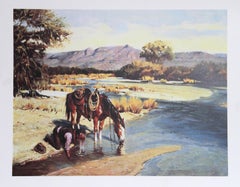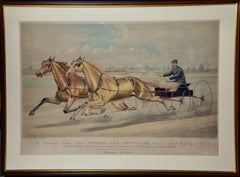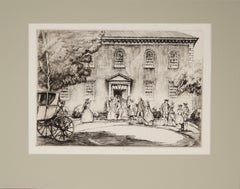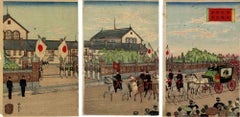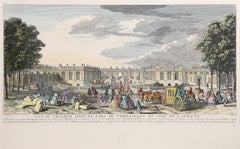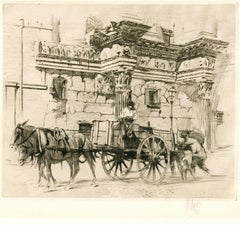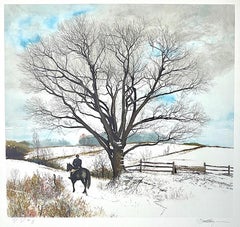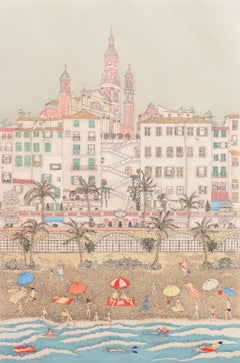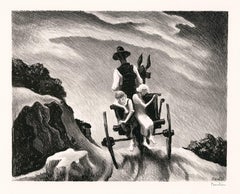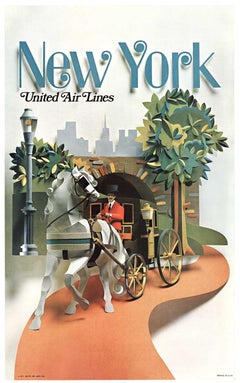Carriage Landscape Prints
to
2
8
5
3
1
1
Overall Width
to
Overall Height
to
3
2
1
1
2
1
1
1
1
2
4
12
1
1
1
1
5
1
17
1
151
7,559
3,776
3,191
2,338
1,867
1,706
1,642
1,614
1,585
1,242
1,085
1,021
977
867
847
725
581
533
529
7
6
5
3
2
2
6
11
6
Art Subject: Carriage
Cooling Off, American Western Art Lithograph by Duane Bryers
By Duane Bryers
Located in Long Island City, NY
Duane Bryers, American (1911 - 2012) - Cooling Off, Year: 1979, Medium: Lithograph, Signed and Numbered in Pencil, Edition: 300, AP, Image Size: 17.5 x 22.5 inches, Size: 21.5 i...
Category
1970s American Realist Landscape Prints
Materials
Lithograph
19th C. Currier & Ives lithograph "Celebrated Trotting Team Edward & Swiveller"
Located in Alamo, CA
This is an original 19th century Currier and Ives hand-colored lithograph entitled "The Celebrated Trotting Team Edward and Swiveller, Owned by Frank Work Esq. N.Y.: Winning their ma...
Category
1880s Animal Prints
Materials
Lithograph
Washington At Pohick Church - 1932 Etching On Paper
Located in Soquel, CA
Washington At Pohick Church - 1932 Etching On Paper
1932 black and white etching depicting George Washington at Pohick Church by Ernest David Roth (German, 1879-1964). George Washin...
Category
1930s American Impressionist Landscape Prints
Materials
Laid Paper, Etching
The Opening of the Temporary Diet - Woodcut by Ginko Adachi- 1890s
Located in Roma, IT
Picture of the opening of the temporary Diet building is an original artwork realized in the 1890s by Ginko Adachi (born 1853; active c. 1870 – 1908).
Sheet dimensions: 22 x 48 cm.
...
Category
1890s Modern Figurative Prints
Materials
Woodcut
Vie de Trianon, Hand-Colored Baroque Engraving by Hyacinthe Rigaud
Located in Long Island City, NY
Vie de Trianon
Hyacinthe Rigaud (After), Catalan/French (1659–1743)
Date: of original: 1750
Hand-Colored Engraving, signed in the plate
Edition of ~1000
Image Size: 8.75 x 18.5 inche...
Category
1970s Baroque Landscape Prints
Materials
Engraving
Forum of Minerva, Assisi, Italy
Located in Middletown, NY
Etching with aquatint on watermarked F J Head & Co. cream laid paper, 9 3/4 x 11 1/2 inches (245 x 290 mm), full margins. Signed in pencil, lower margin. Scattered age tone and mat t...
Category
Early 20th Century Modern Landscape Prints
Materials
Laid Paper, Etching, Aquatint
Toulouse-Lautrec, Composition, Les Affiches De Toulouse-Lautrec (after)
Located in Fairfield, CT
Medium: Lithograph on grand vélin Filigrané a sa marque paper
Year: 1950
Paper Size: 9.75 x 12.5 inches; image size: 7.87 x 10.63 inches
Inscription: Signed in the plate and unnumber...
Category
1950s Post-Impressionist Figurative Prints
Materials
Lithograph
$716 Sale Price
20% Off
E. Mario Grenville, Mail Time
Located in New York, NY
Mario Grenville made this print for the publishing program of Associated American Artists. It was issued in 1945 making it a calm antidote to the ending of World War II, although it ...
Category
1940s Ashcan School Figurative Prints
Materials
Etching
Before the Trotting Race - Original Lithograph Handsigned Numbered
By Yves Brayer
Located in Paris, IDF
Yves Brayer (1907-1990)
Before the Trotting Race
Original lithograph, c.1973
Handsigned in pencil by the artist
Numbered /250 copies
Size 50 x 65 cm, on Arches Vellum
Information: ...
Category
1970s Landscape Prints
Materials
Vellum, Lithograph
A Kodak Moment
Located in San Francisco, CA
This artwork titled "A Kodak Moment" 1992 is an offset lithograph by renown Western artist Gary Carter, born 1938. It is hand signed and numbered 816/850 i...
Category
Late 20th Century American Realist Figurative Prints
Materials
Lithograph
Rue de Castiglione, Folk Art Lithograph by Claude Tabet
Located in Long Island City, NY
Claude Tabet, French (1924 - 1979) - Rue de Castiglione. Medium: Lithograph, signed and numbered in pencil, Edition: 250, EA, Size: 22 x 30 in. (55.88 x 76.2 cm), Description: Either...
Category
Mid-20th Century Folk Art Landscape Prints
Materials
Lithograph
View of the New Trinity House on Tower Hill
Located in Middletown, NY
London: Laurie & Whittle, 1799
Engraving on buff wove paper, 10 3/4 x 15 3/4 inches (271 x 338 mm), uneven narrow to wide margins. Soft vertical fold at the center sheet (as issued)...
Category
Late 18th Century English School Landscape Prints
Materials
Handmade Paper, Engraving
Ancient Views of Kobe - Vintage Albumen Print - 1890s
Located in Roma, IT
Ancient Views of Kobe is an original vintage albumen print on single cardboard: 26 x 34 cm.
They were realized in the 1890s.
Good conditions e...
Category
Late 19th Century Figurative Prints
Materials
Cardboard, Photographic Paper
A View on the Highgate Road and The Birmingham Tally Ho Coach
Located in Douglas, Isle of Man
James Pollard 1892-1867, was an English painter, watercolourist and engraver whose artistic talents were the depiction of coaching, hunting, fishing and horse racing scenes. He is fa...
Category
Mid-19th Century Landscape Prints
Materials
Paper, Printer's Ink, Watercolor
David Loggan St Edmund Hall Oxford - Aula St Edmundi - 1675 engraving
By David Loggan
Located in London, GB
To see our other views of Oxford and Cambridge, scroll down to "More from this Seller" and below it click on "See all from this Seller" - or send us a message if you cannot find the view you want.
David Loggan (1634-1692)
St Edmund Hall...
Category
1670s Realist Prints and Multiples
Materials
Engraving
La Calèche dans le parc, Regards sur Paris, Maurice Brianchon
Located in Auburn Hills, MI
Lithograph on vélin d’Arches paper. Inscription: unsigned and unnumbered, as issued. Good condition. Notes: from the folio, Regards sur Paris, 1962. Published by André Sauret, Paris;...
Category
1960s Modern Landscape Prints
Materials
Lithograph
$876 Sale Price
20% Off
Roman Forum - Etching by Giuseppe Malandrino - 1970s
Located in Roma, IT
Roman Forum is an artwork realized by Giuseppe Malandrino.
Original print in etching technique and hand watercolored.
Hand-signed by the artist in pencil on the lower right corner....
Category
1970s Contemporary Landscape Prints
Materials
Etching
Roman Landscape - Etching by Giuseppe Malandrino - 1970s
Located in Roma, IT
Roman Landscape is an original etching artwork realized by the Italian artist Giuseppe Malandrino.
Hand-signed by the artist on the lower right in pencil. Image Dimensions: 24 x 32 ...
Category
1970s Contemporary Figurative Prints
Materials
Etching
Related Items
HILLTOPPER Signed Lithograph, Winter Landscape, Horse, Equestrian English Riding
Located in Union City, NJ
Hilltopper is an original, hand drawn, limited edition lithograph(not a photo reproductioon or digital print) by Peter Sculthorpe (b.1948 Ontario, Canada) printed using hand lithography techniques on archival Arches paper, 100% acid free. Hilltopper is a finely detailed winter landscape drawing depicting a snow covered hilltop with a lone, English style horseback rider and nature details including dried grasses, branches, and large bare tree firmly anchored to the frozen earth.
Print size - 32 x 27 inches, unframed, excellent condition, pencil signed by Peter Sculthorpe, inscribed PP#8(Printers Proof) aside from the edition of 275
Edition size - 275, plus proofs
Year published - 1989
Printer - J K Fine Art Editions Co. NY
Peter Sculthorpe's paintings are well known for their true to life depictions of rural stone barns, color changing shadowy skies, snow covered landscapes, cows, horses, lone figures that capture the countryside and stone architecture of the Brandywine Valley...
Category
1980s Realist Landscape Prints
Materials
Lithograph
'Beach at Menton', Paris, Ecole des Beaux-Arts, New York, Woman Artist, Madrid
By Cuca Romley
Located in Santa Cruz, CA
Signed, lower right, in pencil, 'Cuca Romley' (Spanish, born 1933), titled 'Plage de Menton' lower center and inscribed, lower left, with number and limitation, '77/175'.
An elegant view of this famous resort town in the South of France with bathers and holiday makers seen on the beach and a view beyond to the famous 17th century, baroque Basilica of St. Michael.
Born in Madrid, Cuca Romley studied at the Ecole des Beaux-Arts in Paris. Over the course of a long career, she has exhibited internationally with success including at the Salon Nacional de Dibujos de Alta Costura...
Category
Late 20th Century Modern Landscape Prints
Materials
Laid Paper, Etching
The West Prospect of the Cathedral of York /// "Britannia Illustrata" Engraving
By Johannes Kip
Located in Saint Augustine, FL
Artist: Johannes "Jan" Kip (Dutch, 1652/3-1722)
Title: "The West Prospect of the Cathedral of York" (Vol. 3, Plate 31)
Portfolio: Britannia Illustrata / Le Nouveau Théâtre de la Grande Bretagne
Year: 1715-1724 (Third edition)
Medium: Original Engraving and Etching on cream laid paper
Limited edition: Unknown
Printer: Joseph Smith, London, UK
Publisher: Joseph Smith, London, UK
Reference: "London Illustrated 1604-1850" - Adams No. 22; Crace No. 201; Brunet IV No. 114; Lowndes No. 1277; Lewine page 263-264
Sheet size: 19.25" x 24.19"
Image size: 16.75" x 22.5"
Condition: With centerfold as issued. Some light toning and foxing mainly in margins, and some light edgewear. Has been professionally stored away for decades. It is otherwise a strong impression in very good condition
Rare
Notes:
Provenance: private collection - Ross-on-Wye, UK. Engraved by Dutch artist Johannes "Jan" Kip (1652/3-1722) after a drawing by Dutch artist Leonard Knyff or Leendert Knijff (1650-1722). Comes from Kip's six volume (including Supplement and 'Atlas Anglois') "Britannia Illustrata" / Le Nouveau Théâtre de la Grande Bretagne", (1724-1728) (Third edition), which consists of 394 engravings and etchings. Printed in one color from one copper plate: black.
Biography:
Johannes "Jan" Kip (1652/53 in Amsterdam - 1722 in Westminster) was a Dutch draftsman, engraver and print dealer. Together with Leonard Knyff, he made a speciality of engraved views of English country houses.
Kip was a pupil of Bastiaen Stopendaal (1636–1707), from 1668 to 1670, before setting up on his own; his earliest dated engravings are from 1672. In April 1680, at the age of 27, he married Elisabeth Breda in Amsterdam. After producing works for the court of William of Orange in Amsterdam, Kip followed William and Mary to London and settled in St. John Street in Farringdon, where he conducted a thriving printselling business. He also worked for various London publishers producing engravings after such artists as Francis Barlow (c. 1626–1704) and Caius Gabriel Cibber (1630–1700), largely for book illustrations. He made several engraved plates for Awnsham & John Churchill's "A Collection of Voyages & Travels" (first published 1704). He signed the African scenes in volume V of the 1732 edition as "J. Kip".
His most important works were the large fold-out folio illustrations for "Britannia Illustrata", 1708; for the 65 folio plates he engraved for the antiquary Sir Robert Atkyns, "The Ancient and Present State of Glostershire", 1712 (1st edition); and for "Le Nouveau Théâtre de la Grande Bretagne ou description exacte des palais de la Reine, et des Maisons les plus considerables des des Seigneurs & des Gentilshommes de la Grande Bretagne", 1715, an extended reprint in collaboration with other artists.
The linked careers of Jan Kip and Leonard Knyff made a specialty of engraved views of English country houses, represented in detail from the bird's-eye view, a pictorial convention for topography. Their major work was "Britannia Illustrata: Or Views of Several of the Queens Palaces, as Also of the Principal seats of the Nobility and Gentry of Great Britain, Curiously Engraven on 80 Copper Plates", London (1707, published in the winter of 1708–9). The volume is among the most important English topographical publications of the 18th century. Architecture is rendered with care, and the settings of parterres and radiating avenues driven through woods or planted across fields, garden paths, gates and toolsheds are illustrated in detail. The images are staffed with figures and horses, coaches pulling into forecourts, water...
Category
1720s Old Masters Landscape Prints
Materials
Laid Paper, Engraving, Etching, Intaglio
SINGLIN' OUT Signed Lithograph, Rocky Mountain Landscape, Cowboy, Horses
Located in Union City, NJ
SINGLIN' OUT by the American Western artist Conrad Schwiering, is a hand drawn limited edition lithograph printed using hand lithography techniques on archival Somerset paper 100% acid free. SINGLIN' OUT is a realistic Western landscape scene set in Wyoming with a backdrop of Wyoming's majestic purple gray Grand Teton mountains...
Category
1980s American Realist Animal Prints
Materials
Lithograph
$300 Sale Price
25% Off
H 21.5 in W 29 in
Stevan Dohanos, Backyard
Located in New York, NY
Stevan Dohanos was an accomplished draftsman who work was widely known through the Saturday Evening Post. This print 'Backyard,' however, leaves aside the illustrative magazine work ...
Category
1930s American Modern Landscape Prints
Materials
Woodcut
Waves of Clouds, Deep Blue Cyanotype Print, Pleasant Cloudy Sky, Large Triptych
By Kind of Cyan
Located in Barcelona, ES
This series of cyanotype triptychs showcases the beauty of nature scenes, including stunning beaches and oceans, as well as the intricate textures of water, forests, and skies. These triptychs are large pieces that feature lush blues, making them an impressive addition to any beautifully designed space.
Each triptych is printed by hand and carefully crafted to capture the unique essence of these natural environments, with a focus on the interplay of light and shadows, and the subtle nuances of tone and texture.
The beach and ocean scenes depict the dynamic beauty of waves crashing against the shore, with the cyanotype process lending a dreamy, ethereal quality to the images. Similarly, the forest and wood scenes...
Category
2010s American Realist Landscape Paintings
Materials
Lithograph, Rag Paper
$704 Sale Price
20% Off
H 40 in W 83 in
Bowling on the Green (from the Bicentennial Pageant of George Washington)
Located in Soquel, CA
Bowling on the Green (from the Bicentennial Pageant of George Washington)
'Bowling on the Green', by printmaker Frederick Childe Hassam, depicts George Washington and friends lawn b...
Category
1930s American Impressionist Figurative Prints
Materials
Ink, Etching, Laid Paper
$1,680
H 16 in W 20 in D 0.25 in
Santa Fe The Chief Way original American railroad poster
Located in Spokane, WA
Original Santa Fe The Chief Way vintage railroad travel poster. Archival linen backed in very fine condition, ready to frame. Most of the Santa Fe Railway posters feature American Indians, but this poster features the big boss, The Chief! The poster has about a 1" white border around the entire image, the linen backing is not counted in the poster's measurement.
Several of the trains were named "Chief" which includes the San Francisco Chief, Texan Chief, Kansas City Chief...
Category
1940s American Impressionist Figurative Prints
Materials
Offset
Original Visitez Les Aquariums Mosans vintage poster
Located in Spokane, WA
"Original Vintage Aquariums Mosans Poster – Art Deco Design by A. de Loof, 1930s European Travel Advertising"
Discover the Captivating "Moselle Aquariums" - A Vintage Poster by A. d...
Category
1930s Art Deco Landscape Prints
Materials
Lithograph
$749
H 38.5 in W 24 in D 0.05 in
Walter DuBois Richards, The Lobster Float
Located in New York, NY
Ohio-born Walter DuBois Richards (1907-2006) was educated at the Cleveland School of Art. He re-located to New York around 1933 where he had a successful career as a commercial artis...
Category
1930s American Modern Landscape Prints
Materials
Woodcut
BUCK RUN BRIDGE Signed Lithograph Historic Covered Bridge Winter Landscape, Cows
Located in Union City, NJ
BUCK RUN BRIDGE is an original, hand drawn, limited edition lithograph(not a photo reproduction or digital print) by Peter Sculthorpe(b.1948 Ontario, Canada) printed in 1990 at JK Fine Art Editions Co. NYC, using hand lithography techniques on archival Arches paper, 100% acid free. Buck Run Bridge depicts a finely detailed drawing of a historic covered bridge in Chester County, Pennsylvania. BUCK RUN BRIDGE is an elongated horizontal composition, image measures 11.5 in. H x 36.75 in. W; a very appealing scenic Pennsylvania winter landscape with subtle details exhibiting fine line drawing and watercolor-like washes blending to form a wintry blue sky. The landscape captivating the viewer's eye with its delicate branches on bare trees, stone walls, split rail...
Category
1990s Realist Landscape Prints
Materials
Lithograph
EARLY JACOULET - A DOWNPOUR AT METALANIM PONOPE EAST CAROLINAS
Located in Santa Monica, CA
EARLY JACOULET
PAUL JACOULET (1896 – 1960)
UNE AVERSEA METALANIM, PONAPE , EST CAROLINES, 1935
A DOWNPOUR AT METALANIM PONOPE EAT CAROLINAS (Miles 29)
Color woodcut, with metallic ...
Category
1930s Modern Figurative Prints
Materials
Woodcut, Color
$1,500
H 15.5 in W 11.75 in
Previously Available Items
'Goin' Home' — WPA Era American Regionalism
Located in Myrtle Beach, SC
Thomas Hart Benton, 'Goin' Home', lithograph, 1937, edition 250, Fath 14. Signed in pencil. Signed in the stone, lower right. A fine, richly-inked impression, on off-white, wove paper, with margins, in excellent condition. Published by Associated American Artists. Archivally matted to museum standards, unframed.
Image size 9 7/16 x 11 7/8 inches; sheet size 10 3/4 x 13 5/16 inches.
Impressions of this work are held in the following museum collections: Figge Art Museum, Georgetown University Art Collection, Indianapolis Museum of Art, Library of Congress, Metropolitan Museum of Art, and the Nelson-Atkins Museum of Art.
ABOUT THE ARTIST
“Benton’s idiom was essentially political and rhetorical, the painterly equivalent of the country stump speeches that were a Benton family tradition. The artist vividly recalled accompanying his father, Maecenas E. Benton — a four-term U.S. congressman, on campaigns through rural Missouri. Young Tom Benton grew up with an instinct for constituencies that led him to assess art on the basis of its audience appeal. His own art, after the experiments with abstraction, was high-spirited entertainment designed to catch and hold an audience with a political message neatly bracketed between humor and local color.”
—Elizabeth Broun “Thomas Hart Benton: A Politician in Art,” Smithsonian Studies in American Art, Spring 1987.
Born in 1889 in Neosho, Missouri, Thomas Hart Benton spent much of his childhood and adolescence in Washington, D.C., where his father, Maecenas Eason Benton, served as a Democratic member of Congress from 1897 to 1905. Hoping to prepare Benton for a political career, his father sent him to Western Military Academy. After nearly two years at the academy, Benton persuaded his mother to support him in attending the Art Institute of Chicago for two years, followed by two additional years at the Académie Julian in Paris.
In 1912, Benton returned to America and moved to New York to pursue his artistic career. One of his first jobs involved painting sets for silent films, which were being produced in Fort Lee, New Jersey. Benton credits this experience with equipping him with the skills necessary to create his large-scale murals.
When World War I broke out, Benton joined the Navy. Stationed in Norfolk, Virginia, he was assigned to create drawings of camouflaged ships arriving at Norfolk Naval Station. These renderings were used to identify vessels that might be lost in battle. Benton later remarked that being a "camofleur" profoundly impacted his career: "When I came out of the Navy after the First World War," he said, "I made up my mind that I wasn’t going to be just a studio painter, a pattern maker in the fashion then dominating the art world—as it still does. I began to think of returning to the painting of subjects, subjects with meanings, which people, in general, might be interested in."
While developing his Regionalist vision, Benton also taught art, first at a city-supported school and later at The Art Students League from 1926 to 1935. One of his students was a young Jackson Pollock, who regarded Benton as both a mentor and father figure. In 1930, Benton was commissioned to paint a mural for the New School for Social Research. The "America Today" mural, now permanently exhibited at the Metropolitan Museum of Art, led to many more commissions as Benton’s work gained wide recognition.
The Regionalist Movement became popular during the Great Depression of the 1930s. Painters such as Benton, Grant Wood, and John Steuart Curry rejected modernist European influences, choosing instead to depict realistic images of small-town and rural life—comforting representations of the American heartland during a period of upheaval. Time Magazine referred to Benton as "the most virile of U.S. painters of the U.S. Scene," featuring his self-portrait on the cover of a 1934 issue that included a story titled "The Birth of Regionalism."
In 1935, Benton left New York and returned to Missouri, where he taught at the Kansas City Art Institute. His outspoken criticism of modern art, art critics, and political views alienated him from many influential figures in both political and art circles. Nonetheless, Benton remained true to his beliefs, continuing to create murals, paintings, and prints that captured enduring images of American life. The dramatic and engaging characteristics of Benton’s artwork drawn the attention of Hollywood producers, leading him to create illustrations and posters for films, including his famous lithographs for the film adaptation of John Steinbeck’s "The Grapes of Wrath," produced by Twentieth Century Fox.
During the 1930s, The Limited Editions Club of New York asked Benton to illustrate special editions of three of Mark Twain’s books...
Category
1930s American Realist Figurative Prints
Materials
Lithograph
Original "New York United Airlines" vintage travel poster Central Park
Located in Spokane, WA
Original travel poster: United Airlines Original Vintage Travel Poster New York. Archival linen backed in very good conditi...
Category
1970s American Modern Landscape Prints
Materials
Offset
H 40.5 in W 25 in D 0.05 in
'Goin' Home' — 1930s American Regionalism
Located in Myrtle Beach, SC
Thomas Hart Benton, 'Goin' Home', lithograph, 1937, edition 250, Fath 14. Signed in pencil. Signed in the stone, lower right. A fine, richly-inked impression, on off-white, wove paper, the full sheet with margins (1 1/4 to 2 3/8 inches), in excellent condition. Published by Associated American Artists. Image size 9 7/16 x 11 7/8 inches (240 x 302 mm); sheet size 11 7/8 x 16 inches (302 x 406 mm). Archivally matted to museum standards, unframed.
Impressions of this work are held in the following museum collections: Figge Art Museum, Georgetown University Art Collection, Indianapolis Museum of Art, Library of Congress, Metropolitan Museum of Art, and the Nelson-Atkins Museum of Art.
ABOUT THE ARTIST
“Benton’s idiom was essentially political and rhetorical, the painterly equivalent of the country stump speeches that were a Benton family tradition. The artist vividly recalled accompanying his father, Maecenas E. Benton — a four-term U.S. congressman, on campaigns through rural Missouri. Young Tom Benton grew up with an instinct for constituencies that led him to assess art on the basis of its audience appeal. His own art, after the experiments with abstraction, was high-spirited entertainment designed to catch and hold an audience with a political message neatly bracketed between humor and local color.” —Elizabeth Broun “Thomas Hart Benton: A Politician in Art,” Smithsonian Studies in American Art, Spring 1987, p. 61
Born in 1889 in Neosho, Missouri, Benton spent much of his childhood and adolescence in Washington, D.C., where his lawyer father, Maecenas Eason Benton, served as a Democratic member of Congress from 1897 to 1905. Hoping to groom him for a political career, Benton’s father sent him to Western Military Academy. After nearly two years at the academy, Benton convinced his mother to support him through two years at the Art Institute of Chicago, followed by two more years at the Academie Julian in Paris.
Benton returned to America in 1912 and moved to New York to pursue his artistic career. One of his first jobs was painting sets for silent movies, which were being produced in Fort Lee, New Jersey. Benton credits this experience with giving him the skills he needed to make his large-scale murals.
When World War I broke out, Benton joined the Navy. Stationed in Norfolk, Virginia, he was assigned to create drawings of the camouflaged ships arriving at Norfolk Naval Station. The renderings were used to identify vessels should they be lost in battle. Benton credited being a ‘camofleur’ as having a profound impact on his career. “When I came out of the Navy after the First World War,” he said, “I made up my mind that I wasn’t going to be just a studio painter, a pattern maker in the fashion then dominating the art world–as it still does. I began to think of returning to the painting of subjects, subjects with meanings, which people, in general, might be interested in.”
While developing his ‘regionalist’ vision, Benton also taught art, first at a city-supported school and then at The Art Students League (1926–1935). One of his students was a young Jackson Pollock, who looked upon Benton as a mentor and a father figure. In 1930, Benton was commissioned to paint a mural for the New School for Social Research. The ‘America Today’ mural, now on permanent exhibit at the Metropolitan Museum of Art, was followed by many more commissions as Benton’s work gained acclaim.
The Regionalist Movement gained popularity during the Great Depression of the 1930s. Painters, including Benton, Grant Wood, and John Steuart Curry, rejected modernist European influences preferring to depict realistic images of small-town and rural life—reassuring images of the American heartland during a period of upheaval. Time Magazine called Benton 'the most virile of U.S. painters of the U.S. Scene,' featuring his self-portrait on the cover of a 1934 issue that included a story about 'The Birth of Regionalism.'
In 1935, Benton left New York and moved back to Missouri, where he taught at the Kansas City Art Institute. Benton’s outspoken criticism of modern art, art critics, and political views alienated him from many influencers in political and art scenes. While remaining true to his beliefs, Benton continued to create murals, paintings, and prints of some of the most enduring images of American life. The dramatic and engaging qualities of Benton’s paintings and murals attracted the attention of Hollywood producers. He was hired to create illustrations and posters for films, including his famous lithographs for the film adaptation of John Steinbeck’s ‘Grapes of Wrath’ produced by Twentieth Century Fox.
Benton’s work can be found at the Art Institute of Chicago, High Museum of Art, Fine Arts Museums of San Francisco, Library of Congress, McNay Art Museum, Metropolitan Museum of Art, Minneapolis Institute of Arts, Montgomery Museum of Fine Arts, National Gallery of Art, Nelson-Atkins Museum of Art, Smithsonian American Art Museum, Whitney Museum of American Art, The Truman Library and many other museums and galleries across the US. He was elected to the National Academy of Design, has illustrated many books, authored his autobiography, and is the subject of ‘Thomas Hart Benton,’ a documentary by Ken Burns.
Category
1930s American Realist Figurative Prints
Materials
Lithograph
